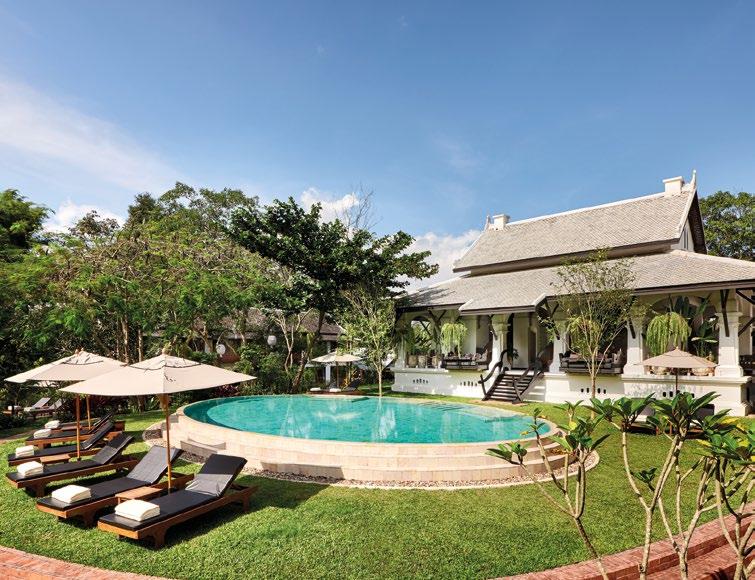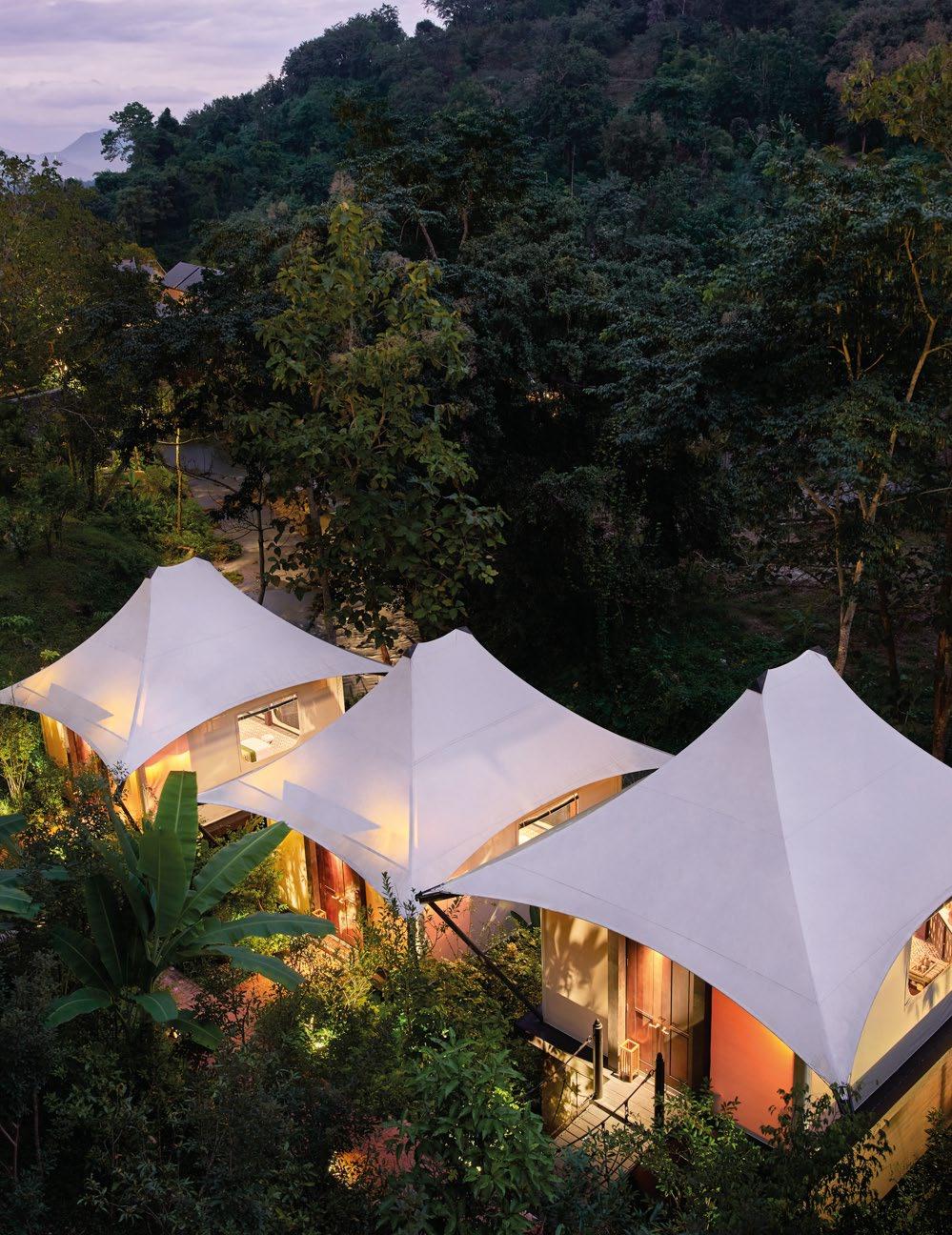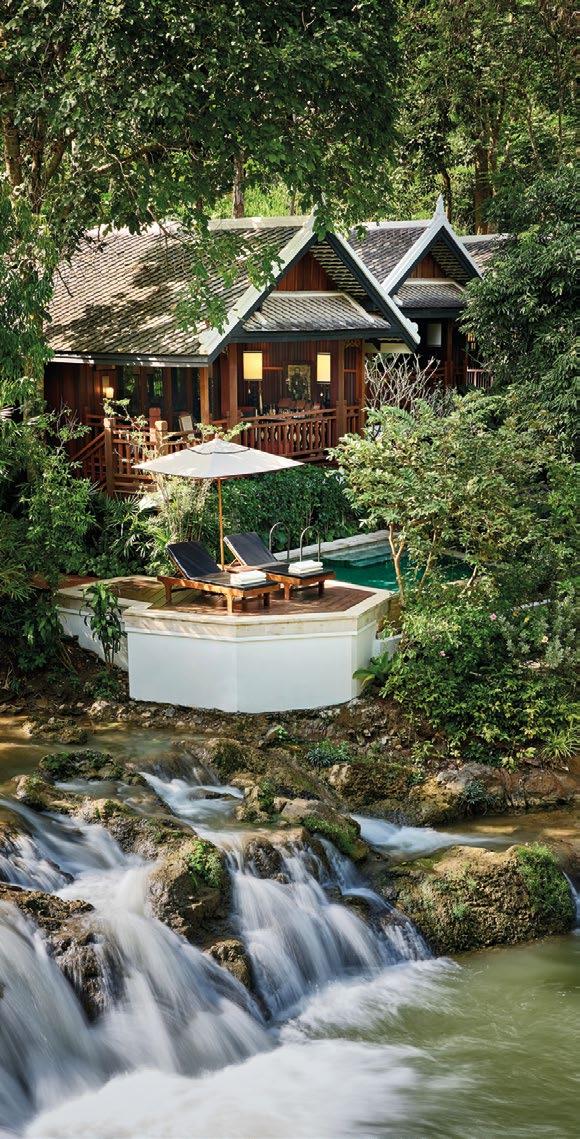
8 minute read
L OA S
A VISIT TO LUANG PRABANG IS OVERFLOWING WITH AUTHENTICITY
BY Murray Ash
When one thinks of Laos, visions may arise of the mighty Mekong River or vast unkempt jungles that once reverberated with the roars of wild elephants. But there's more to this tiny landlocked country than mere natural wonders. In a nation that turns Vietnam War ordnance into fine art for tourists, adaptability and perseverance are at the heart of life. Behind the scenes, Laos' engineers lead hydroelectric energy exportation, paving the way toward a new vision of modern society. Laos has an unquestionably unique identity among the surrounding nations of Thailand, Vietnam and China. Firmly rooted in Buddhist spirituality and tradition, the sum of its constituent parts is still distinctly Laotian. Yet its recent history of French colonialism flavors both its architecture and food. A stay at the magnificent Rosewood Luang Prabang is an experience of translation from past to present. Signaling the rise of a new era for this tiny state, I’m eager to see how luxury travel integrates tradition with the inevitable and fast-approaching globalization of tourism.
It's early morning in the UNESCO World Heritage city of Luang Prabang. Passengers disembark a small plane, descending a rickety staircase onto the hot tarmac. The horizon shimmers and shakes in the mid-morning heat like a translucent and tempting serpentine welcoming us into Eden. A uniformed driver awaits me beside a luxury four-by-four. Inside I find welcome snacks, beverages and wi-fi. The short drive to the Rosewood is an immersive voyage into Laotian society. Giant mansions stand tall beside small wooden shacks, and street vendors sell packets of chips to passing motorcyclists at the side of the road. It doesn't feel pushy here, unlike other South East Asian countries I've visited. No one is bothering anyone, and everyone goes slow.
The sound of crunching rocks signals our arrival as we pull into the graveled hotel driveway. A concierge leads me down a short, winding walkway through a secluded, unassuming opening planted high with shrubbery. The recent French colonial stylings are present in every detail, yet Rosewood Luang Prabang feels undeniably Asian in its welcoming embrace. A path meanders alongside a manicured croquet green. The strong, dark, carved wooden beams of the welcome hall jut out of the landscape behind me, commanding attention. The woodwork overhead is adorned with intricate gold leaf stenciling, and tusk-shaped table legs support the long heavy center table at the hotel's heart. These details connect this establishment back to Laos' meaning of the land of a million elephants.
I check in, lounging on a low-slung traditional dining bed. A refreshing welcome drink of rosella iced tea calms and detoxifies after the early flight. I relax under a symphony of birdsong and dancing tree branches rustling in the wind. This cushioned area of quiet contemplation embraces my tired bones, and I'm brought cold towels to cool my skin. The backdrop is a jungle vista with steady-flowing waterfalls and a sapphire oval swimming pool. In the distance, far above the canopy, cloaked mountains emerge atop mauve rolling clouds.
The pathway leading to the suite is unlike anywhere I've been. An impressive 270 paces lead up through manicured grounds, past a bar stretching out effortlessly over a river. I cross rope bridges and walk along a terracotta parquet brick path toward my room. The Laotian jungle envelopes all. This place feels like it was dreamt up by Edgar Rice Burroughs, albeit short of a vine swing and loin cloth. A symbiotic ecosystem coexisting with man's desire to tame it, manicured forest amongst the wild. Frondescent saplings claw at the well-established trunks of seasoned trees. Deep green leafy tonalities, textures and curved foliage complement the brutalist black planks of wooden bridges. This could be the Mekong rainforest, but it's not; it's home.
I'm shown to my private pool. It's dressed in muted sunlight and flanked by a small staircase to an outdoor dining space. There's a coffee and bar area well stocked with all one could want to enjoy the view of the jungle. Surrounding details are dripping in quality. Marble accents play harmoniously alongside traditional craftsmanship. Inside my room, dark turquoise walls emphasize the wooden rafters overhead, and French folding windows open out over the pool and river below. A chaise lounge is lit by the natural window light and low-hanging lamps on either side. A small table, perfect for resting tea while reading, hosts an old rotary phone for contacting reception. Outside, a large traditional wooden bathtub stands in the sunlight, an optional indulgence over the indoor shower.
Luang Prabang boasts a new fleet of electric cars and bikes in a nod to modernization and vehicular electrification. I rent a tiny electric car the following morning and head out to greet adventure. It's a forty-minute drive through rolling countryside and villages to the Kuang Si Falls. Along the way, I pass golden temples, lush rice fields and grazing water buffalo strolling calmly. When I arrive, I'm greeted with an unexpected sight: moon bears. These furry creatures were rescued from various locations worldwide. They live a life of serenity, playing freely in this open sanctuary. A short hike uphill, and I'm immersed in a cacophony of color and sound. Mineral-rich blue-green waterfalls cascade down smooth dark rocks into natural swimming pools. In every traveler's life, memorable places and times stand out for no reason other than the feeling one has there. For me, this was one of those places. A forever memory of a natural connection to an experience typically lost in the modern world. The water is welcoming and cool, and before long, I dive in and swim under a wall of refreshing water. These waters have a healing quality; when I leave, it's as if I've been reborn. On the drive back to the Rosewood, I stop to take in the sunset at a local eatery. This unassuming lookout has incredible views of the surrounding lakes and forests. I order veggie fried rice and sip on a refreshing Lao Beer. The smell of sun-warmed wood fills the air, and the day feels complete.
I awake the next morning before sunrise, for today is almsgiving. Drawing open the long, thick, black-out drapes, I reveal a peaceful forest view veiled in darkness. Although moist and sticky, the air has yet to offend with its heat. I allow a little extra time striding down the jungle path to take in the stars through gaps in the canopy ceiling, and I listen to the whispers of the dawn wilderness. The time is 4:45 a.m., and my chauffeur awaits. It's a twentyminute drive through town as the sky's morning blue tones warm to something more tangerine. The empty streets of Luang Prabang are quiet now, but for the frequent sighting of monks walking silently in single file.
At sunrise, we reach a temple in Panom Village. I'm given a ceremonial scarf to wear over my shoulder and welcomed to the middle of the temple grounds. I kneel in front of prepared baskets of rice and chopped fresh fruit. Rosewood has a supportive relationship with this temple, and I'm the only tourist to visit. The Laotians welcome me in with smiling faces and open arms. People form a U-shaped space in front of the temple as monks approach carrying metal jugs on a rope. These containers are slung over their shoulder and hold the daily provisions we donate. In my right hand, I take a fistful of sticky rice and, in my left, a few slices of apple. I place the food into the baskets as the monks walk by. After almsgiving, we meditate as a group. The monks bless us by singing and chanting, and we pray to our loved ones. We bless water before pouring it over temple plants. Our guide translates that giving to others like this kills the narrowness of our minds. My brief time living as a monk in the past brings me close to the men in front of me. I wear a few tears of gratitude for their commitment to self-betterment in service of all.
I'm invited into the pagoda to sit for fifteen minutes. A giant statue of Buddha looks out over us, and golden ceremonial gongs sway in the light morning breeze by the temple's entryway. I choose to sit with Anapana meditation, an observation of natural breath. Fifteen minutes turns into thirty, and I feel immensely calm when I open my eyes. We leave the temple around 5:30 a.m. and head to the local morning market Deal Ta Mehay. This wet market feels like something between an Anthony Bourdain episode and a Star Wars movie. The freshly harvested plants, morning catch and recently butchered meat line narrow alleyways. Smells, sights, and chaotic sounds, colorful and intense, are a reminder of life and death. It's refreshingly honest and rarely experienced in the luxury end of travel. This is an experience of authentic life in Luang Prabang.
It's been a long morning with an early start, and I'm ready for breakfast. It's important to remember when in Laos to eat spicy. This isn't just for dinner; heat starts from the day's first meal. I have a bowl of hot beef noodle soup and ground spicy chicken rice, which kicks and awakens my palate. I sip on hot green tea to quench my thirst. I'm perched atop a great bamboo balcony propped up on stilts fifty feet above the Mekong riverbank. Overlooking the mighty waterway that supplies Laos


“In the distance, far above the canopy, cloaked mountains emerge atop mauve rolling clouds. ” and its neighboring countries with food and energy, I listen to boat drivers discuss what I assume is the morning traffic. European-style cafes line the streets and paint a scene of cultural immersion. Live musicians play over the rhythmic chugging of the two-stroke engines, which power the spearlike skiffs across to the far bank. Dilapidated ferries shift cars and people from west to east. The resilience of a community who have faced considerable hardships is invigorating.

It's my final evening at Rosewood Luang Prabang, and I choose to dine at The Great House. The serene sound of the waterfall feeding the babbling brook sets the scene for dinner. Low-fi beats, and low-intensity lights depict a timeless elegance. Red lanterns adorn the surrounding lawn, and moonlight dances across the pool's surface. This indoor/outdoor dining area looks more like a Moroccan palace or Chinese water temple than a Laotian dwelling from some angles. The food arrives in a large wooden boat. Laotians don't drink with dinner; they soup, and what a soup it is. With subtle flavors it's like an amuse bouche to cleanse the palate between dishes. Delicate tastes tantalize my mouth, layered and delivered one by one. Rosewood developed a program named Partners in Provenance, which is dedicated to delivering the highest quality food sourced ethically. I'm served traditional handmade river weed harvested from farmers on the Nam Khan River. The poultry in my lemongrass chicken soup is from a nearby farm in Suang Village. The Paa Khun River Fish in my spicy curry comes from the Nam Ou River. Buffalo mozzarella and feta cheese for the salad is from the local Kuang Si dairy farm, as are free-range chicken eggs. The seasonal vegetables on my plate are grown using water from the river stream on the property. The yellow vegetable soup is the best I've had. Delicate coconut notes soak into the perfectly prepared vegetables and flawlessly complement the famous Laos sausage. This is as local as local gets, and the chef plays with these ingredients masterfully.
I retire to my room, reflecting on my short but impressionable time in Laos. It's challenging to sum this place up. On the one hand, there's immense hardship here. Street vendors work seven days a week to maintain a modest life. They have a real make-do mentality, but it's held with such humble gratitude for their karmic carnation. On the other hand, a few pioneers of industry are shaping the future of this tiny nation. Innovation and development are yet to influence the traditional feel of Laos. Time will tell, but as a global traveler with decades of experience, I can say one thing; visit Laos and do it soon. This kind of place is a diamond in the rough.*










